Leadership and Management Structures: A Vinamilk Case Study
VerifiedAdded on 2022/05/31
|27
|4575
|141
Report
AI Summary
This report provides an in-depth analysis of the management and leadership practices at Vietnam Dairy Products Joint Stock Company (Vinamilk). It begins with an overview of Vinamilk's organizational structure, including the Board of Directors and Board of Management, and examines the roles of key personnel. The report then delves into the definitions, roles, functions, and theories of management, encompassing classical, behavioral, and contingency approaches. It also explores the concepts of leadership, including its roles, functions, and different leadership approaches, and contrasts management and leadership styles. Furthermore, the report presents findings from interviews with Vinamilk's leadership team and direct managers, offering insights into their roles and responses to various situations. The analysis highlights the differences and interdependencies between management and leadership, and their combined impact on Vinamilk's success.
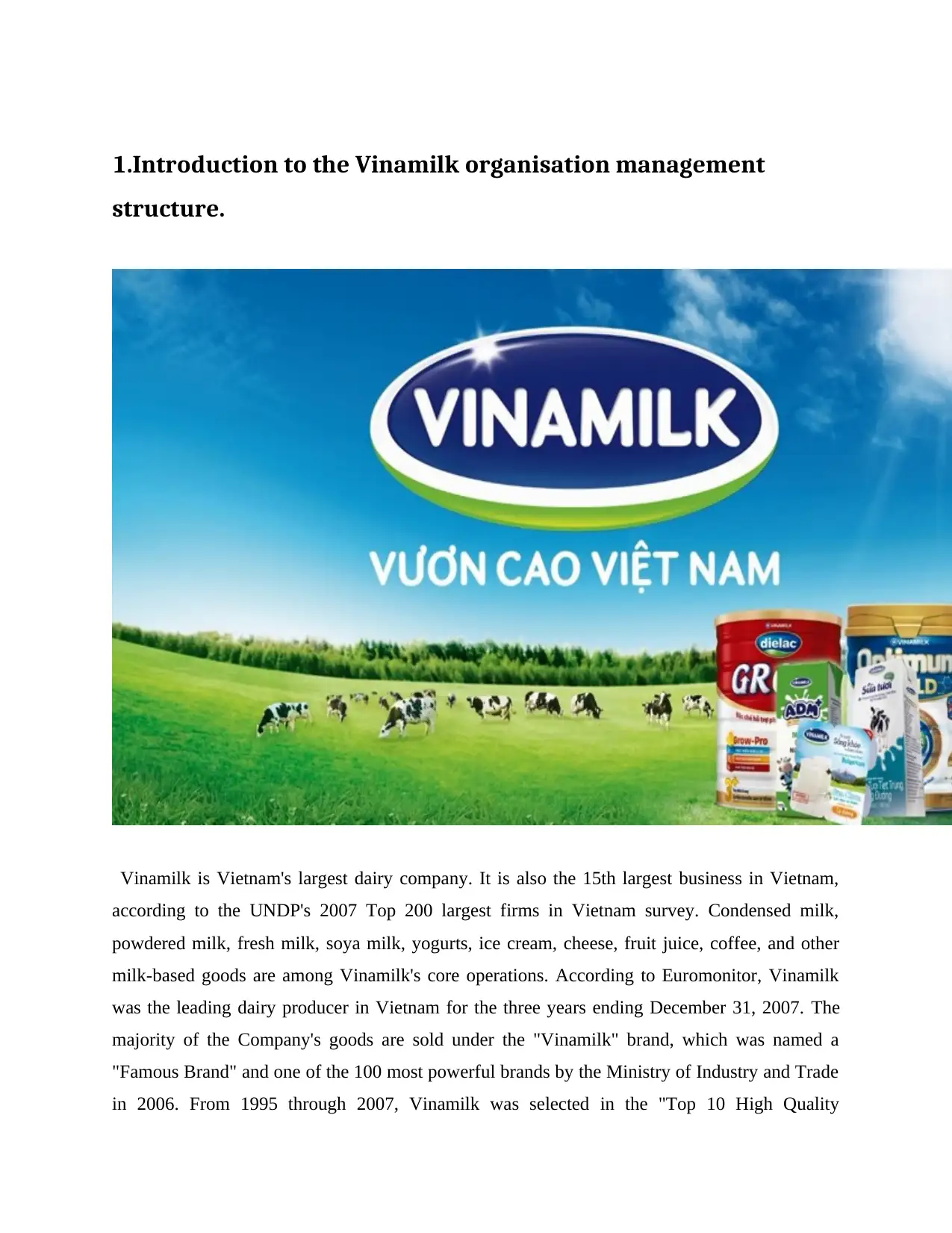
1.Introduction to the Vinamilk organisation management
structure.
“Vinamilk is Vietnam's largest dairy company. It is also the 15th largest business in Vietnam,
according to the UNDP's 2007 Top 200 largest firms in Vietnam survey. Condensed milk,
powdered milk, fresh milk, soya milk, yogurts, ice cream, cheese, fruit juice, coffee, and other
milk-based goods are among Vinamilk's core operations. According to Euromonitor, Vinamilk
was the leading dairy producer in Vietnam for the three years ending December 31, 2007. The
majority of the Company's goods are sold under the "Vinamilk" brand, which was named a
"Famous Brand" and one of the 100 most powerful brands by the Ministry of Industry and Trade
in 2006. From 1995 through 2007, Vinamilk was selected in the "Top 10 High Quality
structure.
“Vinamilk is Vietnam's largest dairy company. It is also the 15th largest business in Vietnam,
according to the UNDP's 2007 Top 200 largest firms in Vietnam survey. Condensed milk,
powdered milk, fresh milk, soya milk, yogurts, ice cream, cheese, fruit juice, coffee, and other
milk-based goods are among Vinamilk's core operations. According to Euromonitor, Vinamilk
was the leading dairy producer in Vietnam for the three years ending December 31, 2007. The
majority of the Company's goods are sold under the "Vinamilk" brand, which was named a
"Famous Brand" and one of the 100 most powerful brands by the Ministry of Industry and Trade
in 2006. From 1995 through 2007, Vinamilk was selected in the "Top 10 High Quality
Paraphrase This Document
Need a fresh take? Get an instant paraphrase of this document with our AI Paraphraser
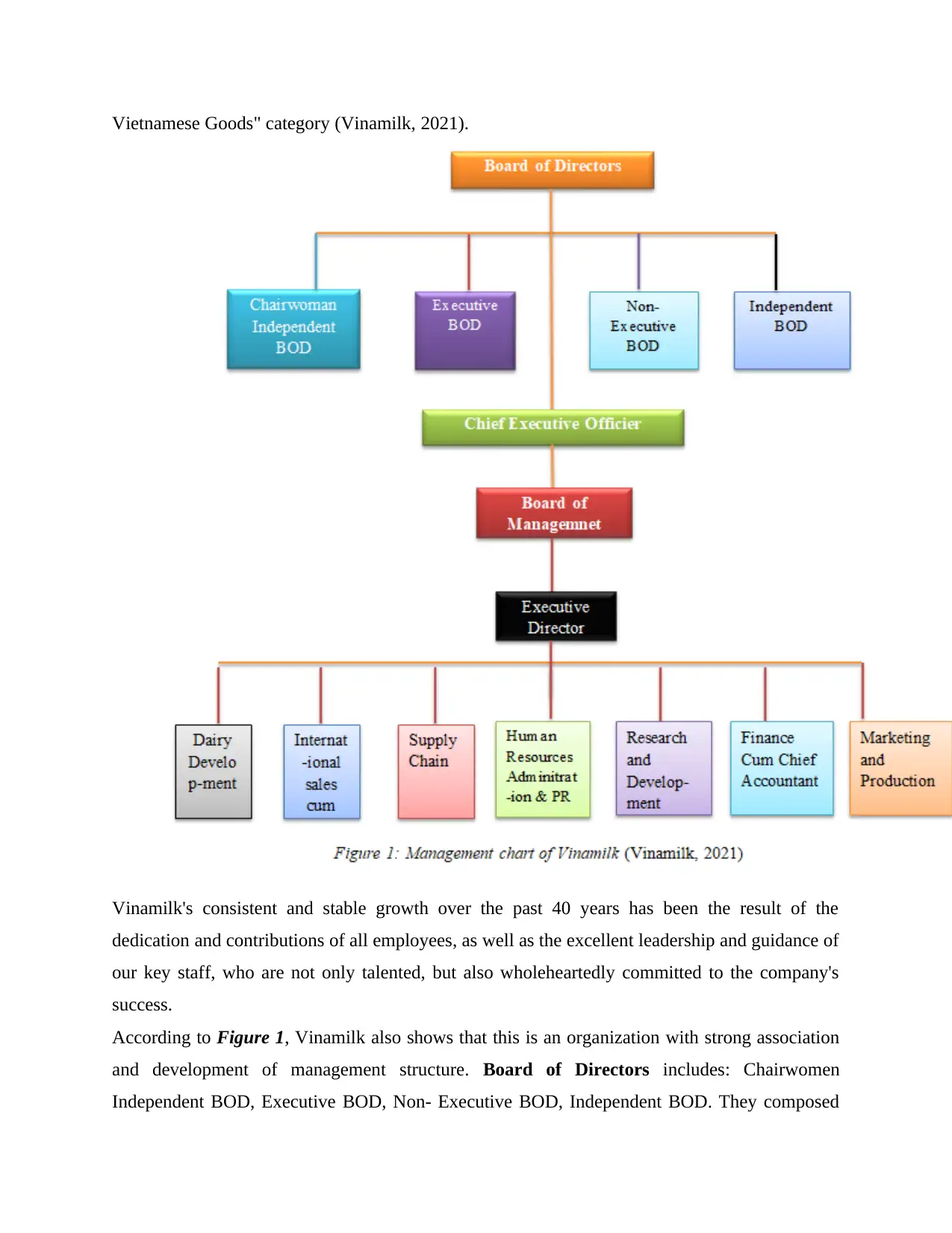
Vietnamese Goods" category (Vinamilk, 2021).”
Vinamilk's consistent and stable growth over the past 40 years has been the result of the
dedication and contributions of all employees, as well as the excellent leadership and guidance of
our key staff, who are not only talented, but also wholeheartedly committed to the company's
success.
According to Figure 1, Vinamilk also shows that this is an organization with strong association
and development of management structure. Board of Directors includes: Chairwomen
Independent BOD, Executive BOD, Non- Executive BOD, Independent BOD. They composed
Vinamilk's consistent and stable growth over the past 40 years has been the result of the
dedication and contributions of all employees, as well as the excellent leadership and guidance of
our key staff, who are not only talented, but also wholeheartedly committed to the company's
success.
According to Figure 1, Vinamilk also shows that this is an organization with strong association
and development of management structure. Board of Directors includes: Chairwomen
Independent BOD, Executive BOD, Non- Executive BOD, Independent BOD. They composed
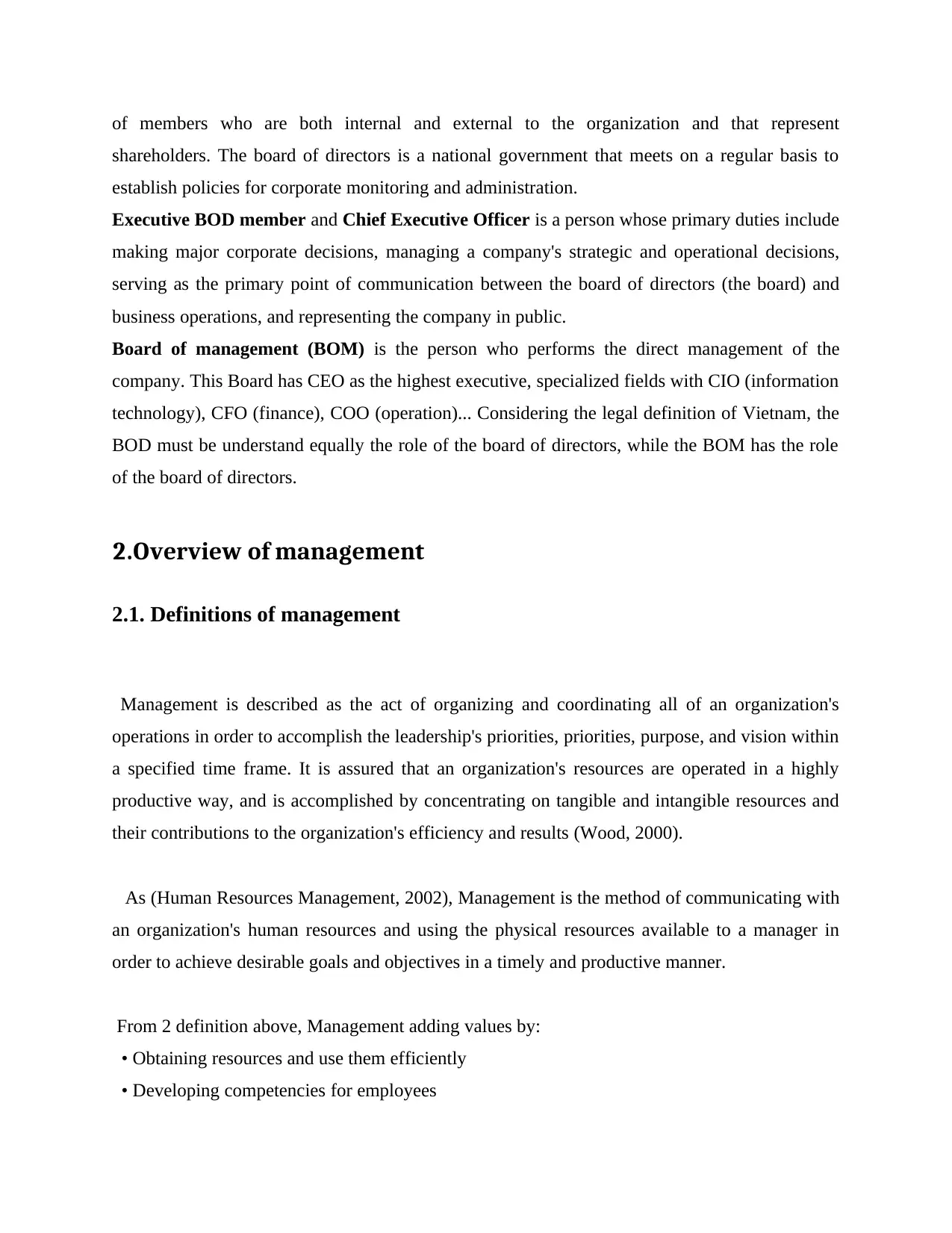
of members who are both internal and external to the organization and that represent
shareholders. The board of directors is a national government that meets on a regular basis to
establish policies for corporate monitoring and administration.
Executive BOD member and Chief Executive Officer is a person whose primary duties include
making major corporate decisions, managing a company's strategic and operational decisions,
serving as the primary point of communication between the board of directors (the board) and
business operations, and representing the company in public.
Board of management (BOM) is the person who performs the direct management of the
company. This Board has CEO as the highest executive, specialized fields with CIO (information
technology), CFO (finance), COO (operation)... Considering the legal definition of Vietnam, the
BOD must be understand equally the role of the board of directors, while the BOM has the role
of the board of directors.
2.Overview of management
2.1. Definitions of management
“Management is described as the act of organizing and coordinating all of an organization's
operations in order to accomplish the leadership's priorities, priorities, purpose, and vision within
a specified time frame. It is assured that an organization's resources are operated in a highly
productive way, and is accomplished by concentrating on tangible and intangible resources and
their contributions to the organization's efficiency and results (Wood, 2000).”
“ As (Human Resources Management, 2002), Management is the method of communicating with
an organization's human resources and using the physical resources available to a manager in
order to achieve desirable goals and objectives in a timely and productive manner.”
From 2 definition above, Management adding values by:
• Obtaining resources and use them efficiently
• Developing competencies for employees
shareholders. The board of directors is a national government that meets on a regular basis to
establish policies for corporate monitoring and administration.
Executive BOD member and Chief Executive Officer is a person whose primary duties include
making major corporate decisions, managing a company's strategic and operational decisions,
serving as the primary point of communication between the board of directors (the board) and
business operations, and representing the company in public.
Board of management (BOM) is the person who performs the direct management of the
company. This Board has CEO as the highest executive, specialized fields with CIO (information
technology), CFO (finance), COO (operation)... Considering the legal definition of Vietnam, the
BOD must be understand equally the role of the board of directors, while the BOM has the role
of the board of directors.
2.Overview of management
2.1. Definitions of management
“Management is described as the act of organizing and coordinating all of an organization's
operations in order to accomplish the leadership's priorities, priorities, purpose, and vision within
a specified time frame. It is assured that an organization's resources are operated in a highly
productive way, and is accomplished by concentrating on tangible and intangible resources and
their contributions to the organization's efficiency and results (Wood, 2000).”
“ As (Human Resources Management, 2002), Management is the method of communicating with
an organization's human resources and using the physical resources available to a manager in
order to achieve desirable goals and objectives in a timely and productive manner.”
From 2 definition above, Management adding values by:
• Obtaining resources and use them efficiently
• Developing competencies for employees
⊘ This is a preview!⊘
Do you want full access?
Subscribe today to unlock all pages.

Trusted by 1+ million students worldwide
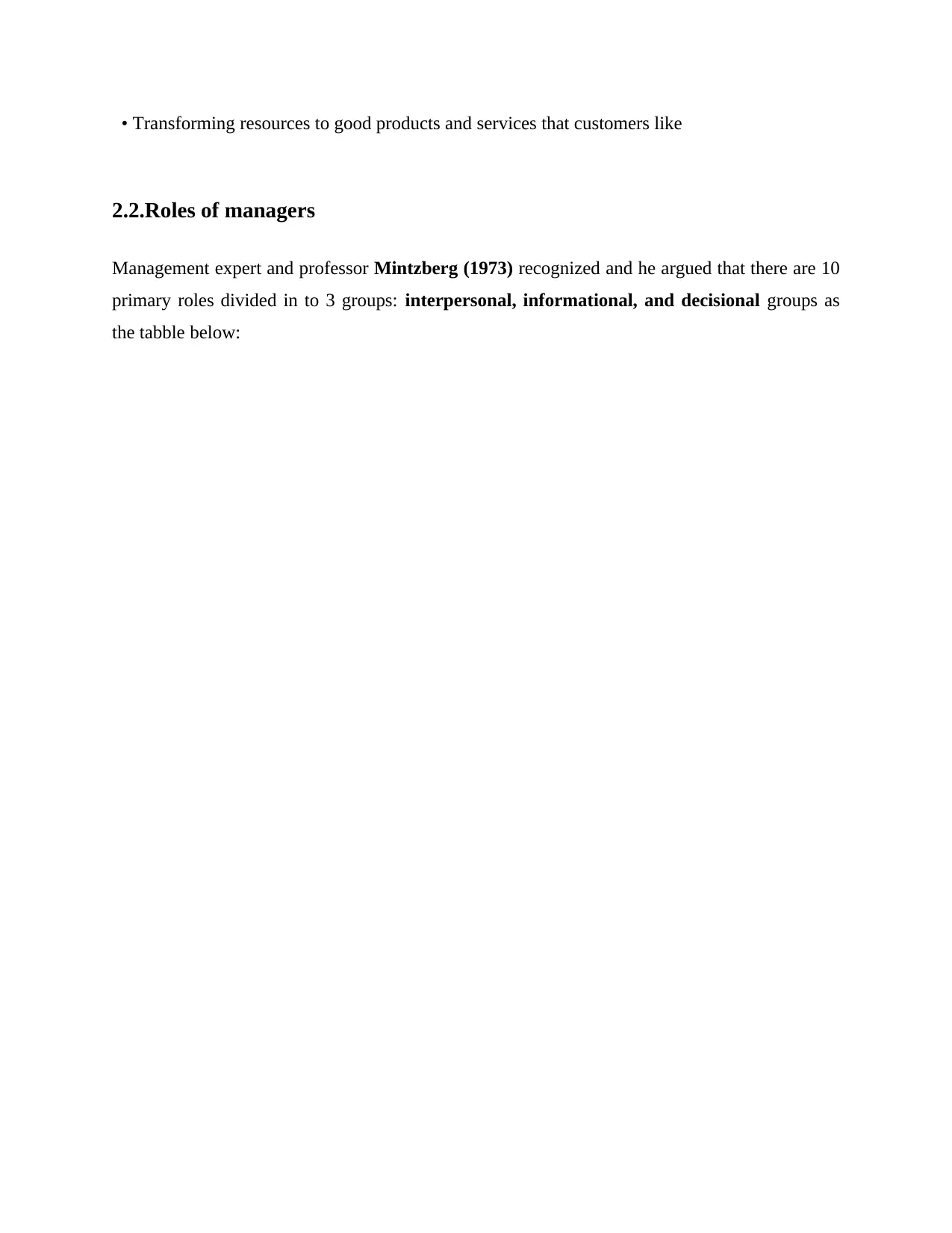
• Transforming resources to good products and services that customers like
2.2.Roles of managers
Management expert and professor Mintzberg (1973) recognized and he argued that there are 10
primary roles divided in to 3 groups: interpersonal, informational, and decisional groups as
the tabble below:
2.2.Roles of managers
Management expert and professor Mintzberg (1973) recognized and he argued that there are 10
primary roles divided in to 3 groups: interpersonal, informational, and decisional groups as
the tabble below:
Paraphrase This Document
Need a fresh take? Get an instant paraphrase of this document with our AI Paraphraser
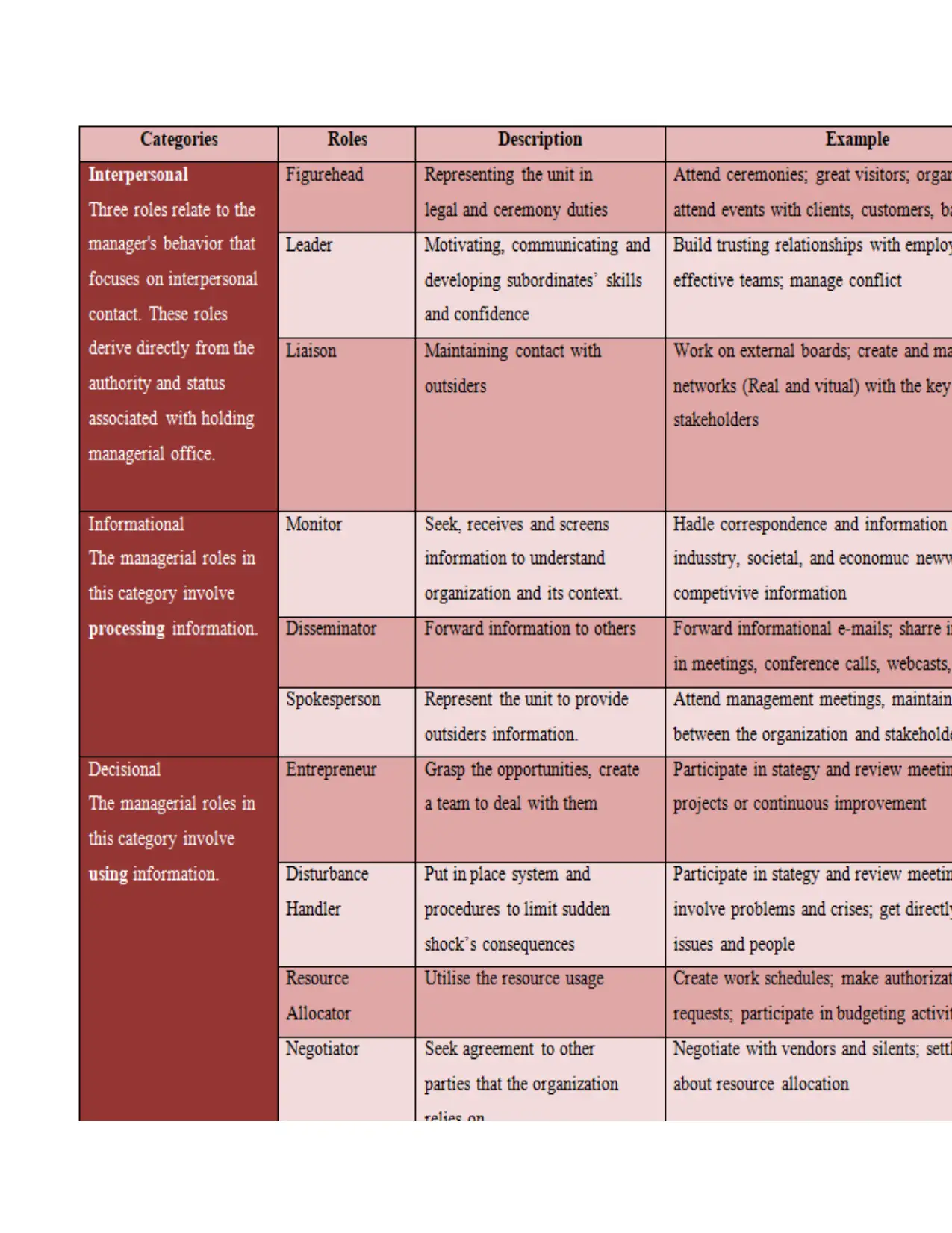
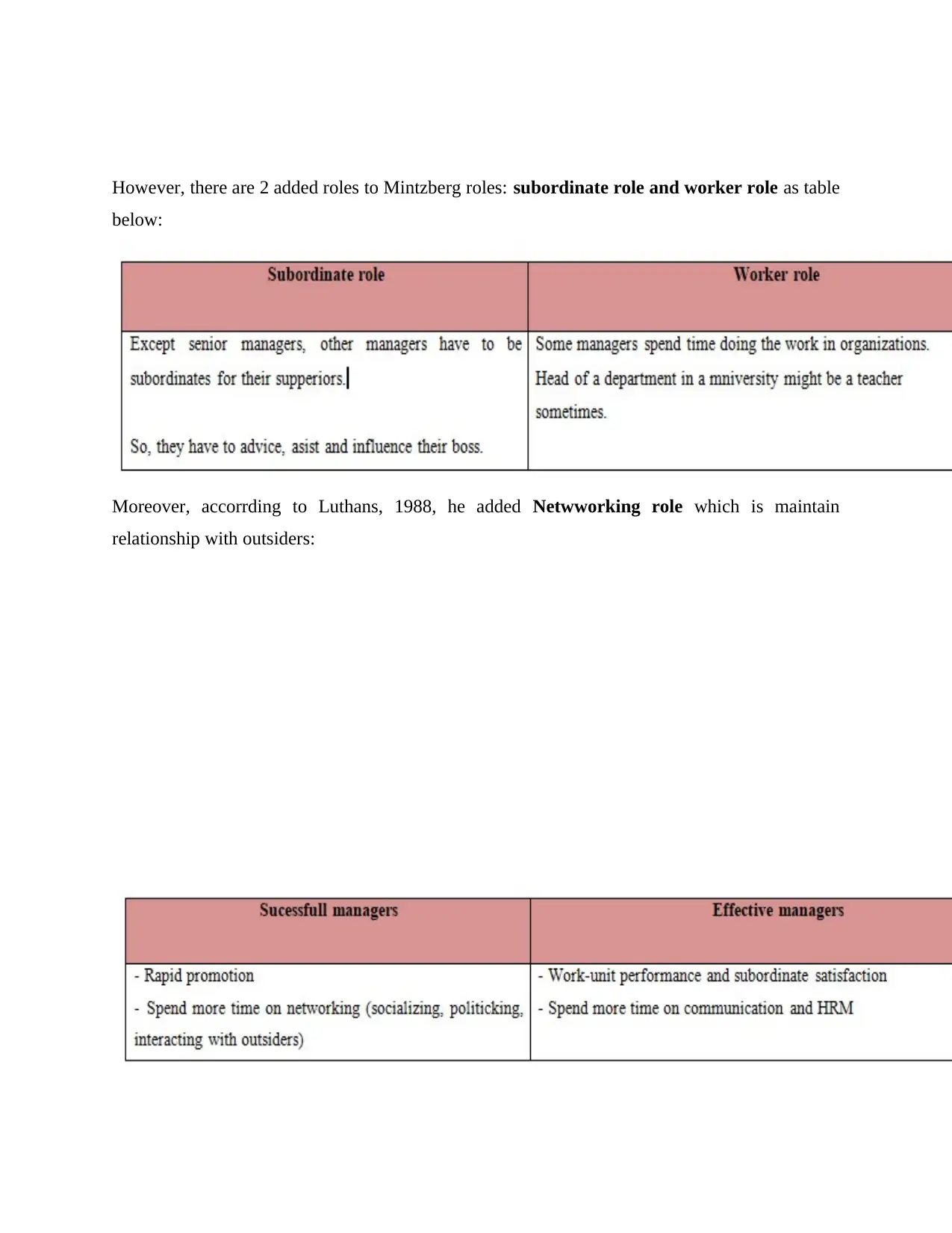
However, there are 2 added roles to Mintzberg roles: subordinate role and worker role as table
below:
Moreover, accorrding to Luthans, 1988, he added Netwworking role which is maintain
relationship with outsiders:
below:
Moreover, accorrding to Luthans, 1988, he added Netwworking role which is maintain
relationship with outsiders:
⊘ This is a preview!⊘
Do you want full access?
Subscribe today to unlock all pages.

Trusted by 1+ million students worldwide
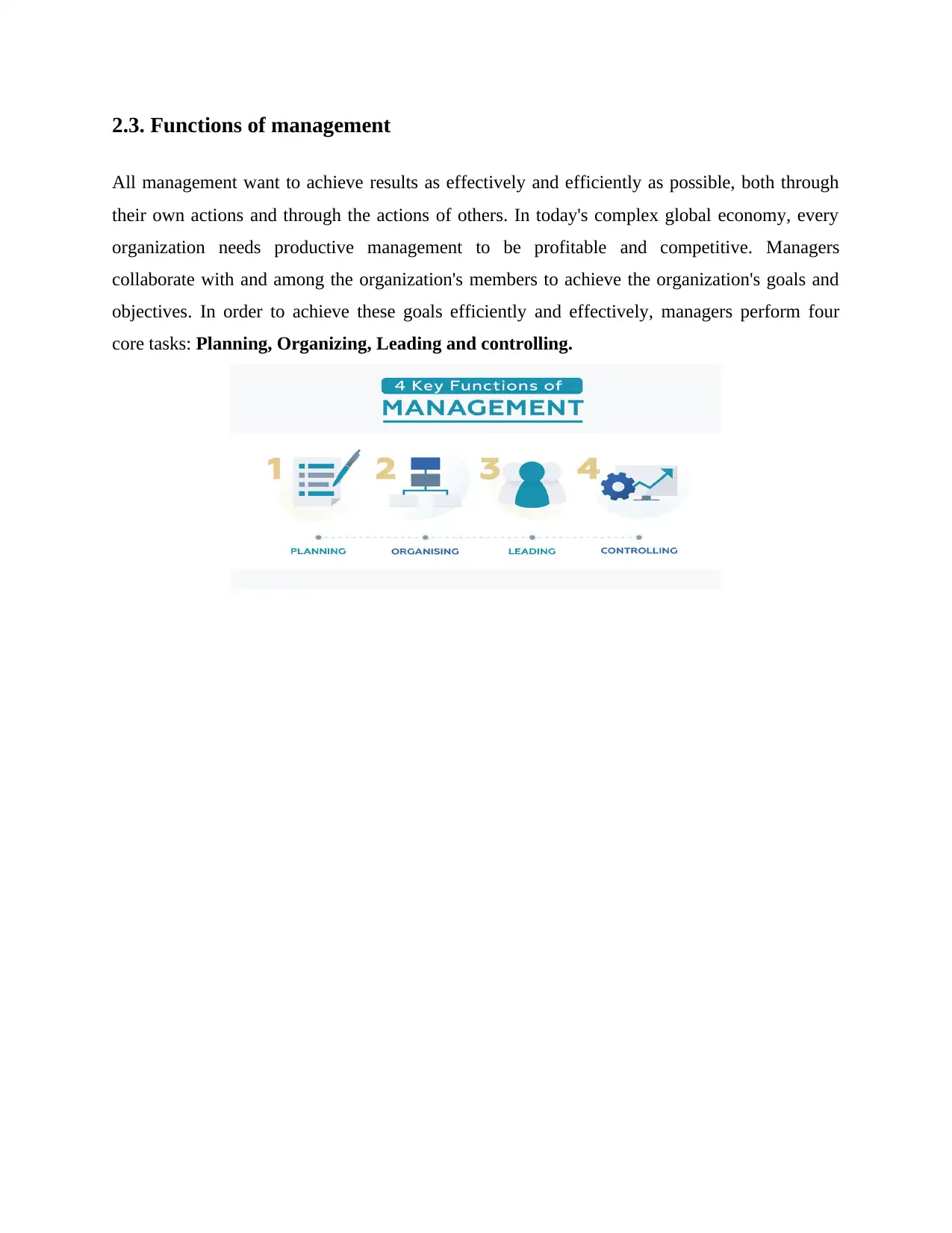
2.3. Functions of management
All management want to achieve results as effectively and efficiently as possible, both through
their own actions and through the actions of others. In today's complex global economy, every
organization needs productive management to be profitable and competitive. Managers
collaborate with and among the organization's members to achieve the organization's goals and
objectives. In order to achieve these goals efficiently and effectively, managers perform four
core tasks: Planning, Organizing, Leading and controlling.
All management want to achieve results as effectively and efficiently as possible, both through
their own actions and through the actions of others. In today's complex global economy, every
organization needs productive management to be profitable and competitive. Managers
collaborate with and among the organization's members to achieve the organization's goals and
objectives. In order to achieve these goals efficiently and effectively, managers perform four
core tasks: Planning, Organizing, Leading and controlling.
Paraphrase This Document
Need a fresh take? Get an instant paraphrase of this document with our AI Paraphraser
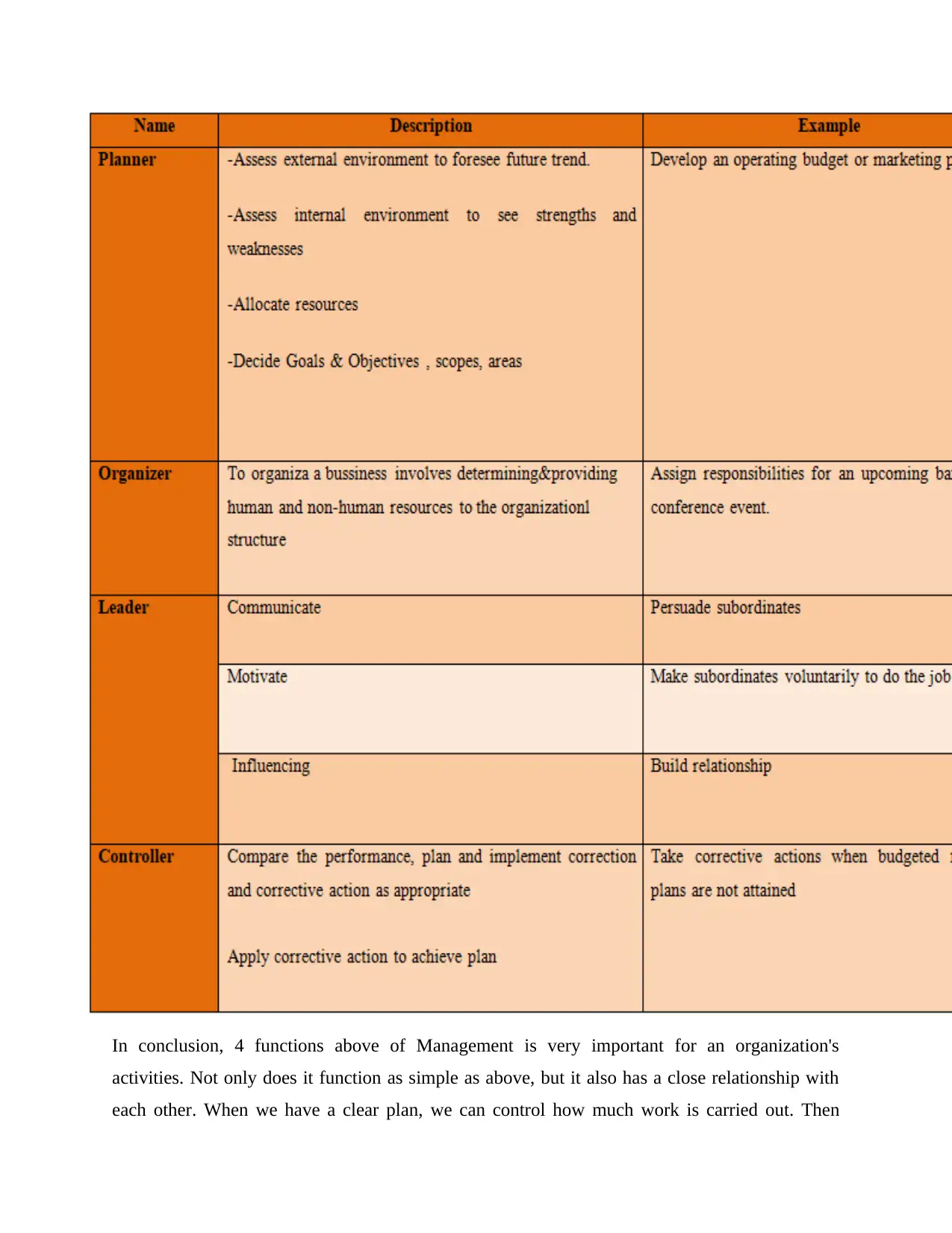
In conclusion, 4 functions above of Management is very important for an organization's
activities. Not only does it function as simple as above, but it also has a close relationship with
each other. When we have a clear plan, we can control how much work is carried out. Then
activities. Not only does it function as simple as above, but it also has a close relationship with
each other. When we have a clear plan, we can control how much work is carried out. Then
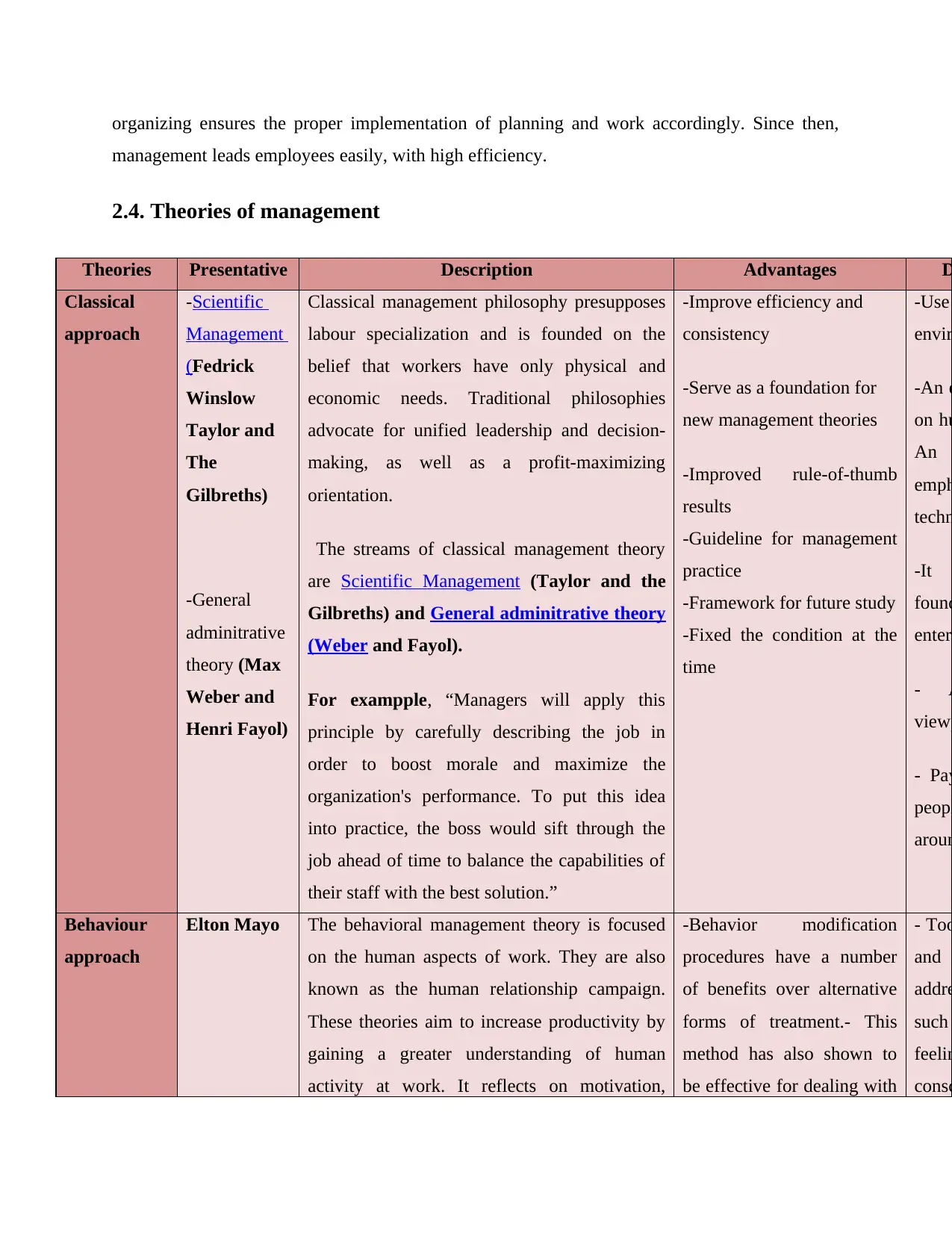
organizing ensures the proper implementation of planning and work accordingly. Since then,
management leads employees easily, with high efficiency.
2.4. Theories of management
Theories Presentative Description Advantages D
Classical
approach
-Scientific
Management
(Fedrick
Winslow
Taylor and
The
Gilbreths)
-General
adminitrative
theory (Max
Weber and
Henri Fayol)
Classical management philosophy presupposes
labour specialization and is founded on the
belief that workers have only physical and
economic needs. Traditional philosophies
advocate for unified leadership and decision-
making, as well as a profit-maximizing
orientation.
The streams of classical management theory
are Scientific Management (Taylor and the
Gilbreths) and General adminitrative theory
(Weber and Fayol).
For exampple, “Managers will apply this
principle by carefully describing the job in
order to boost morale and maximize the
organization's performance. To put this idea
into practice, the boss would sift through the
job ahead of time to balance the capabilities of
their staff with the best solution.”
-Improve efficiency and
consistency
-Serve as a foundation for
new management theories
-Improved rule-of-thumb
results
-Guideline for management
practice
-Framework for future study
-Fixed the condition at the
time
-Use
envir
-An e
on hu
An
emph
techn
-It
found
enterp
- A
viewp
- Pay
peopl
aroun
Behaviour
approach
Elton Mayo The behavioral management theory is focused
on the human aspects of work. They are also
known as the human relationship campaign.
These theories aim to increase productivity by
gaining a greater understanding of human
activity at work. It reflects on motivation,
-Behavior modification
procedures have a number
of benefits over alternative
forms of treatment.- This
method has also shown to
be effective for dealing with
- Too
and
addre
such
feelin
consc
management leads employees easily, with high efficiency.
2.4. Theories of management
Theories Presentative Description Advantages D
Classical
approach
-Scientific
Management
(Fedrick
Winslow
Taylor and
The
Gilbreths)
-General
adminitrative
theory (Max
Weber and
Henri Fayol)
Classical management philosophy presupposes
labour specialization and is founded on the
belief that workers have only physical and
economic needs. Traditional philosophies
advocate for unified leadership and decision-
making, as well as a profit-maximizing
orientation.
The streams of classical management theory
are Scientific Management (Taylor and the
Gilbreths) and General adminitrative theory
(Weber and Fayol).
For exampple, “Managers will apply this
principle by carefully describing the job in
order to boost morale and maximize the
organization's performance. To put this idea
into practice, the boss would sift through the
job ahead of time to balance the capabilities of
their staff with the best solution.”
-Improve efficiency and
consistency
-Serve as a foundation for
new management theories
-Improved rule-of-thumb
results
-Guideline for management
practice
-Framework for future study
-Fixed the condition at the
time
-Use
envir
-An e
on hu
An
emph
techn
-It
found
enterp
- A
viewp
- Pay
peopl
aroun
Behaviour
approach
Elton Mayo The behavioral management theory is focused
on the human aspects of work. They are also
known as the human relationship campaign.
These theories aim to increase productivity by
gaining a greater understanding of human
activity at work. It reflects on motivation,
-Behavior modification
procedures have a number
of benefits over alternative
forms of treatment.- This
method has also shown to
be effective for dealing with
- Too
and
addre
such
feelin
consc
⊘ This is a preview!⊘
Do you want full access?
Subscribe today to unlock all pages.

Trusted by 1+ million students worldwide
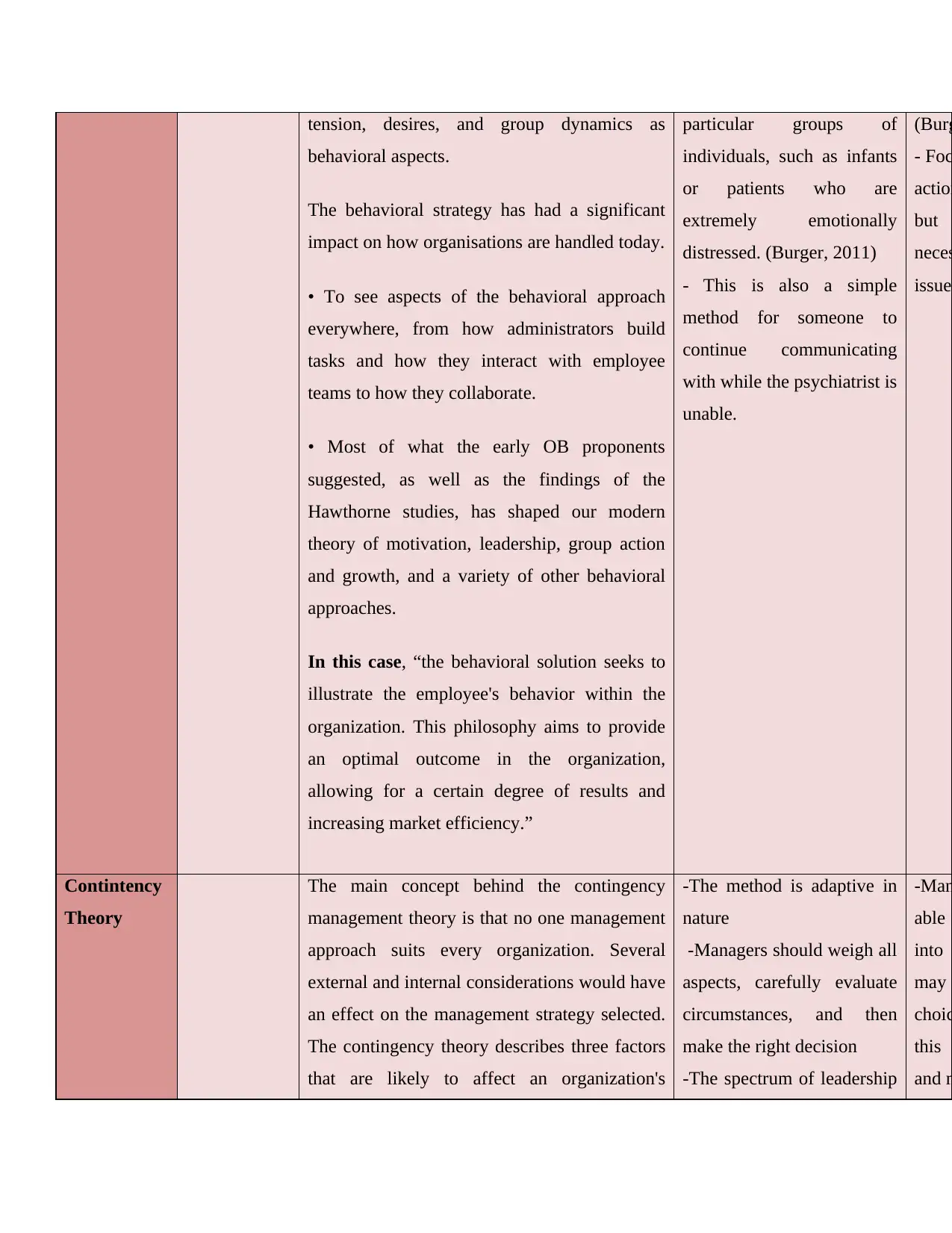
tension, desires, and group dynamics as
behavioral aspects.
The behavioral strategy has had a significant
impact on how organisations are handled today.
• To see aspects of the behavioral approach
everywhere, from how administrators build
tasks and how they interact with employee
teams to how they collaborate.
• Most of what the early OB proponents
suggested, as well as the findings of the
Hawthorne studies, has shaped our modern
theory of motivation, leadership, group action
and growth, and a variety of other behavioral
approaches.
In this case, “the behavioral solution seeks to
illustrate the employee's behavior within the
organization. This philosophy aims to provide
an optimal outcome in the organization,
allowing for a certain degree of results and
increasing market efficiency.”
particular groups of
individuals, such as infants
or patients who are
extremely emotionally
distressed. (Burger, 2011)
- This is also a simple
method for someone to
continue communicating
with while the psychiatrist is
unable.
(Burg
- Foc
action
but
neces
issues
Contintency
Theory
The main concept behind the contingency
management theory is that no one management
approach suits every organization. Several
external and internal considerations would have
an effect on the management strategy selected.
The contingency theory describes three factors
that are likely to affect an organization's
-The method is adaptive in
nature
-Managers should weigh all
aspects, carefully evaluate
circumstances, and then
make the right decision
-The spectrum of leadership
-Man
able
into
may
choic
this
and m
behavioral aspects.
The behavioral strategy has had a significant
impact on how organisations are handled today.
• To see aspects of the behavioral approach
everywhere, from how administrators build
tasks and how they interact with employee
teams to how they collaborate.
• Most of what the early OB proponents
suggested, as well as the findings of the
Hawthorne studies, has shaped our modern
theory of motivation, leadership, group action
and growth, and a variety of other behavioral
approaches.
In this case, “the behavioral solution seeks to
illustrate the employee's behavior within the
organization. This philosophy aims to provide
an optimal outcome in the organization,
allowing for a certain degree of results and
increasing market efficiency.”
particular groups of
individuals, such as infants
or patients who are
extremely emotionally
distressed. (Burger, 2011)
- This is also a simple
method for someone to
continue communicating
with while the psychiatrist is
unable.
(Burg
- Foc
action
but
neces
issues
Contintency
Theory
The main concept behind the contingency
management theory is that no one management
approach suits every organization. Several
external and internal considerations would have
an effect on the management strategy selected.
The contingency theory describes three factors
that are likely to affect an organization's
-The method is adaptive in
nature
-Managers should weigh all
aspects, carefully evaluate
circumstances, and then
make the right decision
-The spectrum of leadership
-Man
able
into
may
choic
this
and m
Paraphrase This Document
Need a fresh take? Get an instant paraphrase of this document with our AI Paraphraser
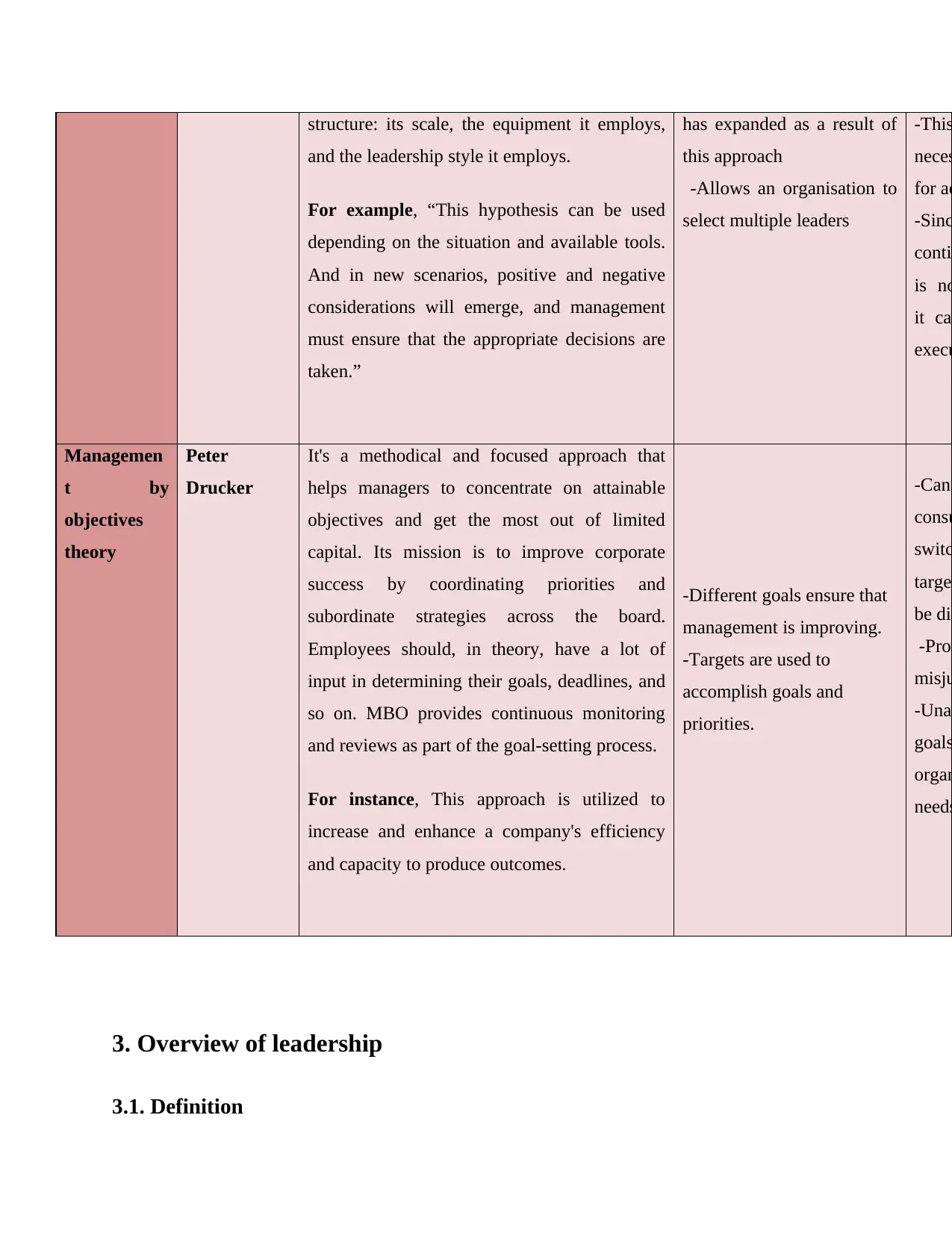
structure: its scale, the equipment it employs,
and the leadership style it employs.
For example, “This hypothesis can be used
depending on the situation and available tools.
And in new scenarios, positive and negative
considerations will emerge, and management
must ensure that the appropriate decisions are
taken.”
has expanded as a result of
this approach
-Allows an organisation to
select multiple leaders
-This
neces
for ad
-Sinc
contin
is no
it can
execu
Managemen
t by
objectives
theory
Peter
Drucker
It's a methodical and focused approach that
helps managers to concentrate on attainable
objectives and get the most out of limited
capital. Its mission is to improve corporate
success by coordinating priorities and
subordinate strategies across the board.
Employees should, in theory, have a lot of
input in determining their goals, deadlines, and
so on. MBO provides continuous monitoring
and reviews as part of the goal-setting process.
For instance, This approach is utilized to
increase and enhance a company's efficiency
and capacity to produce outcomes.
-Different goals ensure that
management is improving.
-Targets are used to
accomplish goals and
priorities.
-Can
consu
switc
target
be dif
-Proc
misju
-Unab
goals
organ
needs
3. Overview of leadership
3.1. Definition
and the leadership style it employs.
For example, “This hypothesis can be used
depending on the situation and available tools.
And in new scenarios, positive and negative
considerations will emerge, and management
must ensure that the appropriate decisions are
taken.”
has expanded as a result of
this approach
-Allows an organisation to
select multiple leaders
-This
neces
for ad
-Sinc
contin
is no
it can
execu
Managemen
t by
objectives
theory
Peter
Drucker
It's a methodical and focused approach that
helps managers to concentrate on attainable
objectives and get the most out of limited
capital. Its mission is to improve corporate
success by coordinating priorities and
subordinate strategies across the board.
Employees should, in theory, have a lot of
input in determining their goals, deadlines, and
so on. MBO provides continuous monitoring
and reviews as part of the goal-setting process.
For instance, This approach is utilized to
increase and enhance a company's efficiency
and capacity to produce outcomes.
-Different goals ensure that
management is improving.
-Targets are used to
accomplish goals and
priorities.
-Can
consu
switc
target
be dif
-Proc
misju
-Unab
goals
organ
needs
3. Overview of leadership
3.1. Definition
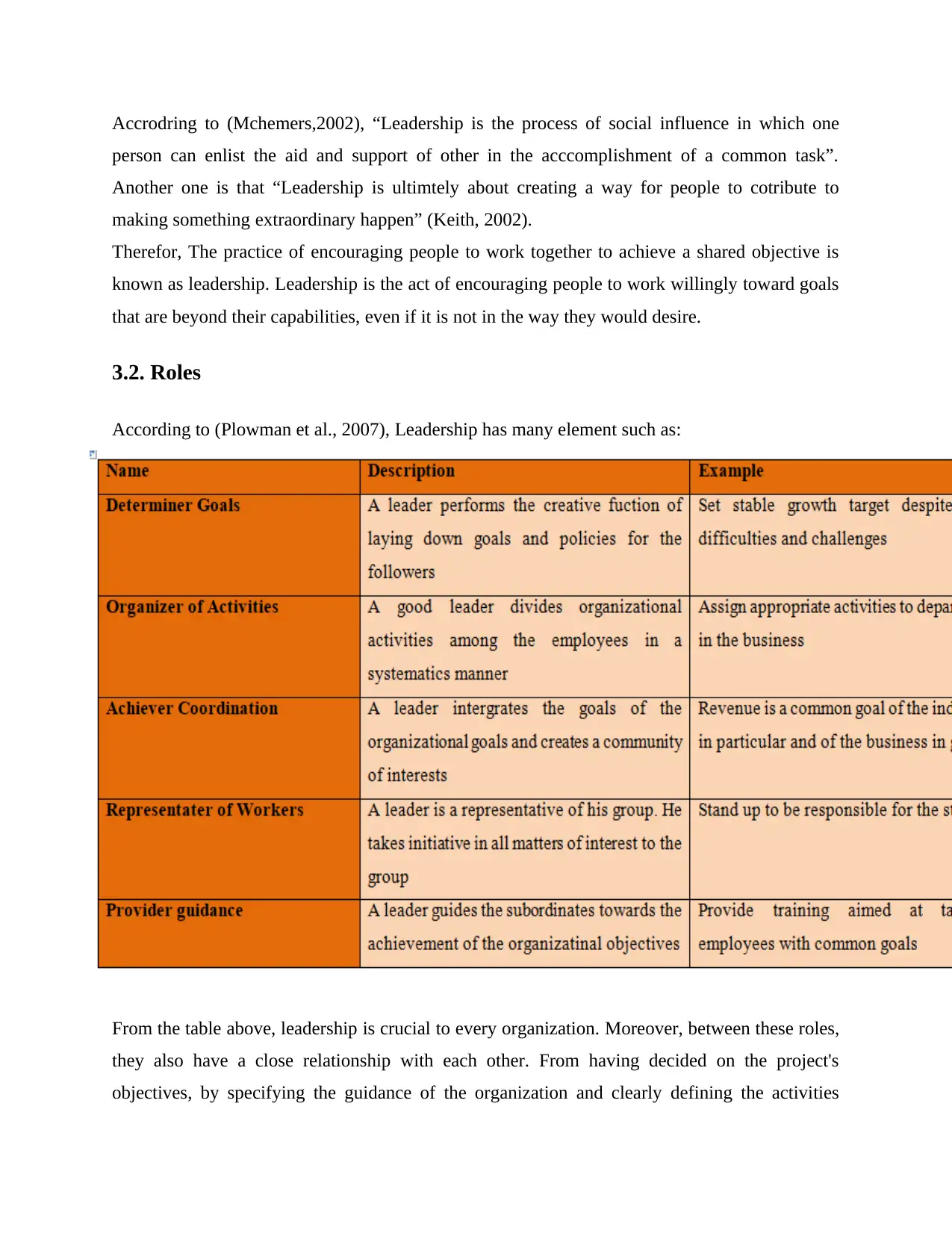
Accrodring to (Mchemers,2002), “Leadership is the process of social influence in which one
person can enlist the aid and support of other in the acccomplishment of a common task”.
Another one is that “Leadership is ultimtely about creating a way for people to cotribute to
making something extraordinary happen” (Keith, 2002).
Therefor, The practice of encouraging people to work together to achieve a shared objective is
known as leadership. Leadership is the act of encouraging people to work willingly toward goals
that are beyond their capabilities, even if it is not in the way they would desire.
3.2. Roles
According to (Plowman et al., 2007), Leadership has many element such as:
From the table above, leadership is crucial to every organization. Moreover, between these roles,
they also have a close relationship with each other. From having decided on the project's
objectives, by specifying the guidance of the organization and clearly defining the activities
person can enlist the aid and support of other in the acccomplishment of a common task”.
Another one is that “Leadership is ultimtely about creating a way for people to cotribute to
making something extraordinary happen” (Keith, 2002).
Therefor, The practice of encouraging people to work together to achieve a shared objective is
known as leadership. Leadership is the act of encouraging people to work willingly toward goals
that are beyond their capabilities, even if it is not in the way they would desire.
3.2. Roles
According to (Plowman et al., 2007), Leadership has many element such as:
From the table above, leadership is crucial to every organization. Moreover, between these roles,
they also have a close relationship with each other. From having decided on the project's
objectives, by specifying the guidance of the organization and clearly defining the activities
⊘ This is a preview!⊘
Do you want full access?
Subscribe today to unlock all pages.

Trusted by 1+ million students worldwide
1 out of 27
Related Documents
Your All-in-One AI-Powered Toolkit for Academic Success.
+13062052269
info@desklib.com
Available 24*7 on WhatsApp / Email
![[object Object]](/_next/static/media/star-bottom.7253800d.svg)
Unlock your academic potential
Copyright © 2020–2025 A2Z Services. All Rights Reserved. Developed and managed by ZUCOL.





